You may have heard that the Moon is hopeless for gardening and for growing crops, and that Mars is the "go to" place for a prospective astronaut gardener. But is it? As it turns out, the Moon has some advantages over Mars, especially if you can plant your garden in a habitat or greenhouse on its summits of sunlight at the poles.
Yes, it is rather chilly there, at -30° C (-22 °F), but there is no weather, good or bad, and the vacuum of space is a good insulator (like a thermos flask). The temperature at the poles is steady, varying by only 10 °C (18 °F) up or down. That's warm enough to keep a well insulated habitat or greenhouse at a comfortable temperature of 20° C (68 °F) year round with sunlight piped in from solar collectors.
(You can also read this article as part of my new book "If You Love Science, Please Don't Rush to Mars" , available on kindle, and also to read for free online.)
It's sunny at the poles, 24/7, year round, except during solar eclipses, and for a few days of the year when the sun dips below the horizon. This is a frame from a charming Russian movie about the Moon made in 1965, before humans landed there.
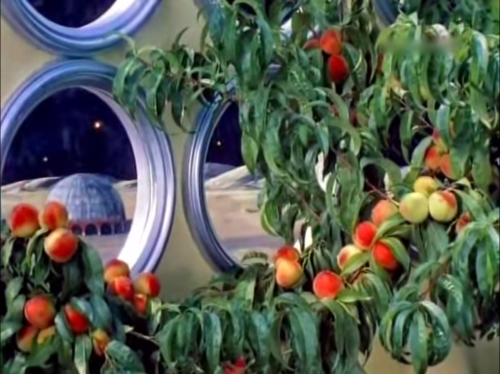
Looking out on the lunar surface from inside a Moon city, in a frame from the 1965 Russian film Luna
And here is a section of the movie itself with the peaches a few seconds in:
You can also watch The full movie, in restored colour, with machine translation subtitles for part of it.
The ESA now wants to go back to the Moon together with Russia and many other international partners, and build a base at one of the summits of sunlight - the "peaks of (almost) eternal light".

The modern ESA moon village idea.
The main thing Mars has going for it is its day just short of 24 hours 40 minutes, similar to Earth, while the Moon's night is two weeks long. However, Mars's dust storms can block out 99% of the sunlight for weeks on end, leading to occasional periods of darkness as long as the lunar night, or longer.
Here is a photo showing progression of a dust storm as seen by Opportunity.
In the middle of this dust storm, less than 1% of the light that reaches the top of the Mars atmosphere made its way to the ground where Opportunity photographed it.
These storms often continue for weeks on end, and the dust storm season happens every two Earth years. In dust storms like this, artificial light is needed to grow plants, much as it is during the lunar night.
Mars is also further from the sun, with only half the levels of sunlight Earth receives. Its nights get so cold, below -78.5 °C (-109.3 °F), that its atmosphere starts to freeze out as dry ice for two hundred days of the year, even in the Martian "tropics", and it has a vacuum so hard that ice sublimes straight into gas, rather like dry ice does on Earth, without turning into water first.
You might think that the thin carbon dioxide atmosphere of Mars is an advantage, but plants only need trace amounts in the atmosphere (we have less than 0.04%). Actually, if an astronaut gardener can grow enough crops to eat, the people eating the crops exhale enough carbon dioxide for the next generation of crops. While if they don't grow all their own food, the carbon dioxide builds up and needs to be scrubbed. So carbon dioxide is more likely to be a problem gas to scrub from the atmosphere of a space habitat, and indeed that's been the situation in all the spacecraft and space stations built to date.

Frosts on Mars - this photograph from Viking 2 is mildly enhanced to bring out the colour of the frost. These often form at night when the air gets so cold that even in the Martian "tropics", carbon dioxide freezes out as dry ice for 200 days of the 687 day long Mars year, carrying water with it as ice. In the day time on Mars the temperatures can get well above zero at times, so there are large day to night swings in temperature which would make it harder to maintain a steady temperature inside a greenhouse.
Also the thin atmosphere makes almost no difference to greenhouse construction. Even if your greenhouse is pressurized to the minimum pressure usually suggested for greenhouses in space, of 10% of Earth's atmosphere, so that you can go into it without the moisture lining your lungs boiling, it doesn't help much. It still has to withstand nearly a ton of outwards pressure per square meter on the walls of the greenhouse, not much different from the situation on the Moon. Greenhouses on Mars or the Moon are likely to be dome shaped to hold in the immense outwards pressure of the atmosphere inside. For more on this, with the calculations, see Greenhouse construction - comparison of the Moon and Mars

Detail of lunar colony showing a greenhouse inside a base. Detail from image from NASA, 1989. This was for the Lunar Oasis proposal for a ten year program to establish a self sufficient science outpost on the Moon to act as a test bed for space settlements.
If you build a greenhouse on the Moon or on Mars it has to withstand getting on for a ton per square meter of outwards pressure even at a tenth of an atmosphere. It might be easiest to just put it inside your habitat as shown here. It could be illuminated with efficient modern LED lights which require little by way of electricity and don't have problems of excess heat to get rid of. You could also pipe the light from the sun into the habitat using optical fibres connected to solar collectors
The Moon is a major challenge for gardeners too, it's no paradise. It has no atmosphere at all, and apart from the polar regions, it has huge swings of temperature, and those two week long nights. But perhaps it can be made into a place to grow food more readily than Mars, especially if you can set up your garden in a habitat or greenhouse on the sunlit summits of the peaks of almost eternal sunlight at its poles.
The lunar caves also work out well compared to Mars, as we'll see. They have a constant temperature, actually a little warmer than the sunlit summits, at -20° C. Again, at those temperatures, it would be easy to warm up a lunar cave habitat or greenhouse enough for plants, if it is well insulated, as it would be. The night time darkness is the main problem with the caves, but as it turns out, its two weeks long night is not nearly as problematic for plants as you might think. That's the result of some rather surprising experiments with wheat, beet etc done by the Russians, and advances in LED technology.
We now know that the moon has water ice and other volatiles at the poles,. so there may well be plenty of water there for gardening. It is in darkness, and so can't be photographed from orbit, and the two main ways of detecting it from orbit (radar and reduced levels of neutron emissions) come up with different answers. We don't know for sure where it came from either (though comet impacts might be a good guess). But some think it is up to two meters thick layers of ice, and if so it may be easy to extract, with possibly hundreds of millions of tons, or a billion tons of them enough water for everyone in a city of a million to have the equivalent of an olympic swimming lane filled with water.
24/7 SOLAR POWER AT THE LUNAR POLES
The Moon is very different from Earth with its month long "day". But it has another difference which makes all the difference to the polar regions . Unlike Earth and Mars which have an axial tilt of over twenty degrees, the Moon has a tilt of only a bit over 1 degree ( 1.5424°). It's remarkable that the Moon's axis is so vertical.
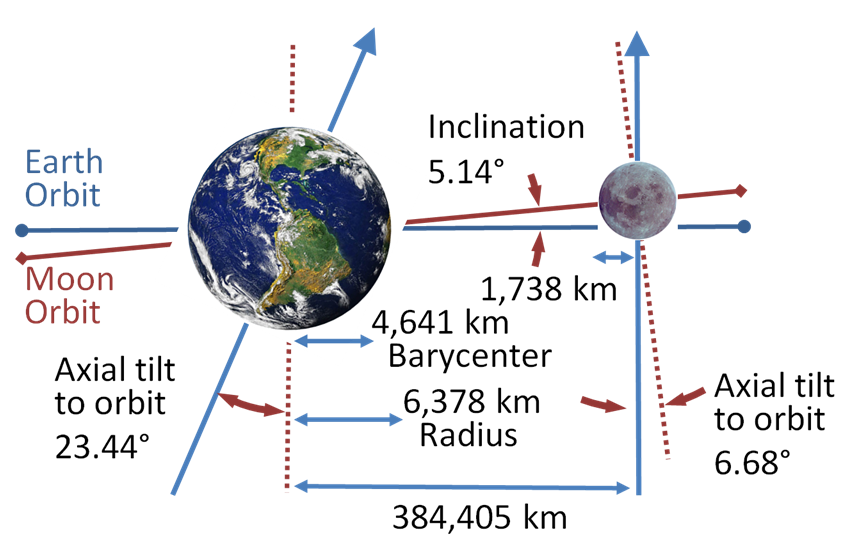
Diagram from NASA. With the Moon's orbit tilted by 5.14°, Earth tilted by 23.4°, yet the Moon's axis is pretty much vertical, only tilted by 1.5424° to the ecliptic (the apparent path of the sun through the sky). This remarkable coincidence is the reason the Moon's poles are so habitable.
Earth has seasons because of its axial tilt of around 23.4° at present (varies slightly by around one degree or so between 22° 2′ 33″ and 24° 30′ 16″ with a period of 41.040 years).
As a result, the Moon has no seasons, and you get points at the poles in almost constant sunlight, the peaks of eternal night. Habitats in those sunny spots can be kept warm just using solar collectors. Right next to them are permanently shaded craters that haven't seen sunlight for billions of years. There's indirect evidence that they may trap millions of tons of water, ammonia and carbon dioxide, possibly the results of comet impacts on the Moon.
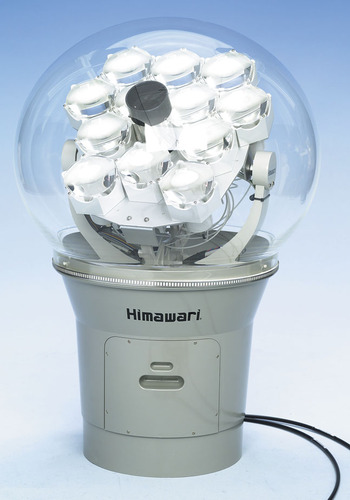
Hamiwari sun tracking solar collector - the light is collected, focused and sent through fiber optics to the interior of the spacecraft or habitat, where it can be used as a light source for algae or growing crops, or to help keep it warm. For details of how this would work for spacecraft, see page 319 of Peter Eckart's book: Spacecraft Life Support and Biospherics.
Solar collectors like this could be used to pipe sunlight into a polar base, or into cave habitats or greenhouses
See peaks of (almost) eternal light in the online NASA astrobiology magazine).
When you are at the lunar poles, it's like a perpetual Arctic or Antarctic equinox, with the sun skimming the horizon, seeming to circle around you once every 28 days. This makes it easy to mount solar photovoltaic panels and solar collectors, to follow the sun and get maximum solar power. They just need to be mounted vertically, and turned slowly once a month.
DEALING WITH PERIODS OF DARKNESS AT THE LUNAR POLES
Even though the "peaks of (almost) eternal light" experience nearly continuous sunlight, they do go dark during eclipses. Also depending on the local topography, they have periods of darkness of several days at a time.
One way to deal with this is to raise the fibre optics solar collectors and solar photovoltaic panels on towers.
This idea goes back at least to 1990. If the Moon was a perfect sphere, then you would be able to achieve sunlight 24/7 (except during eclipses) with a tower 622 meters high.
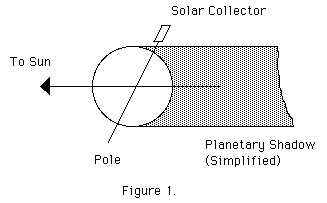
Figure 1 from Arnold Reinhold's paper
See the section Description of idea in this paper A Solar Powered Station at a Lunar Pole by Arnold Reinhold. That's a major construction project but it would be easier to build on the Moon.
However the Moon isn't perfectly spherical of course, and the peaks of (almost) eternal light are quite high already. So your tower wouldn't need to be as tall as that. As it turns out, you can make quite a difference with a tower only 10 or 20 meters high.
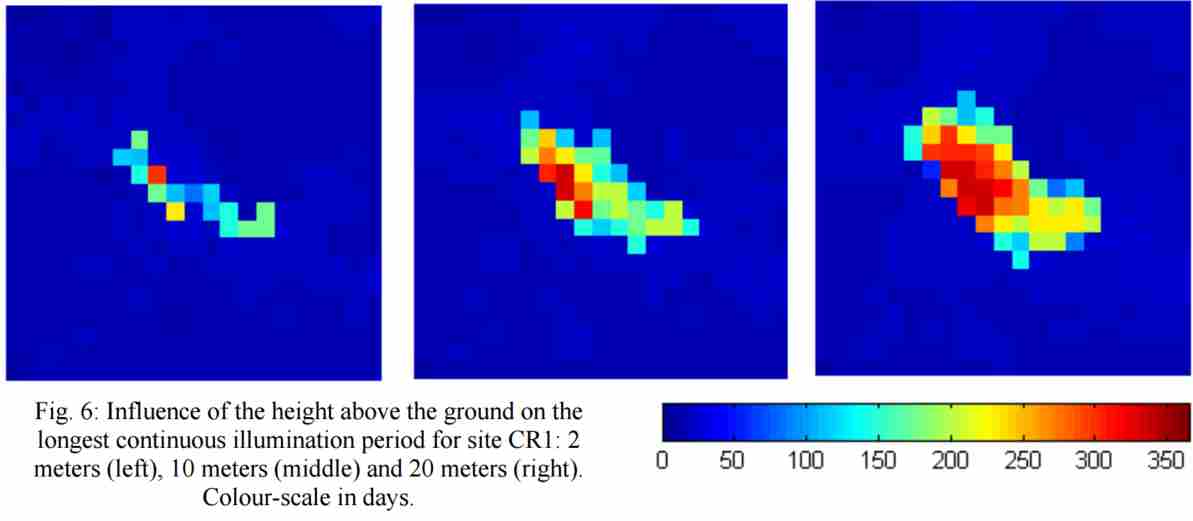
This figure shows the difference it makes to put the solar collectors or solar panels on a pole 10 meters high and then 20 meters high, to raise them above nearby obstacles, from this paper.
With the best location in this paper, near the South pole (see page 1077), a mast 10 meters high increased the average solar visibility from 92.66 to 95.83, and reduces the number of days of darkness in the year from 26 down to 15. So it can make quite a difference.
Another approach is to find points close to each other such that one is in daylight when the other is in darkness. You can then route power from one to the other via a powerline, or you can transmit the power using microwaves or lasers. One example here, page 9 two points 12 km apart, together have sunlight 97% of the year. Another example here, points A and B 10 km apart on page 562, figure 6b - B is illuminated for 82% of the year but when you combine it with A, then the result is illuminated 94% of the year.
This is another example
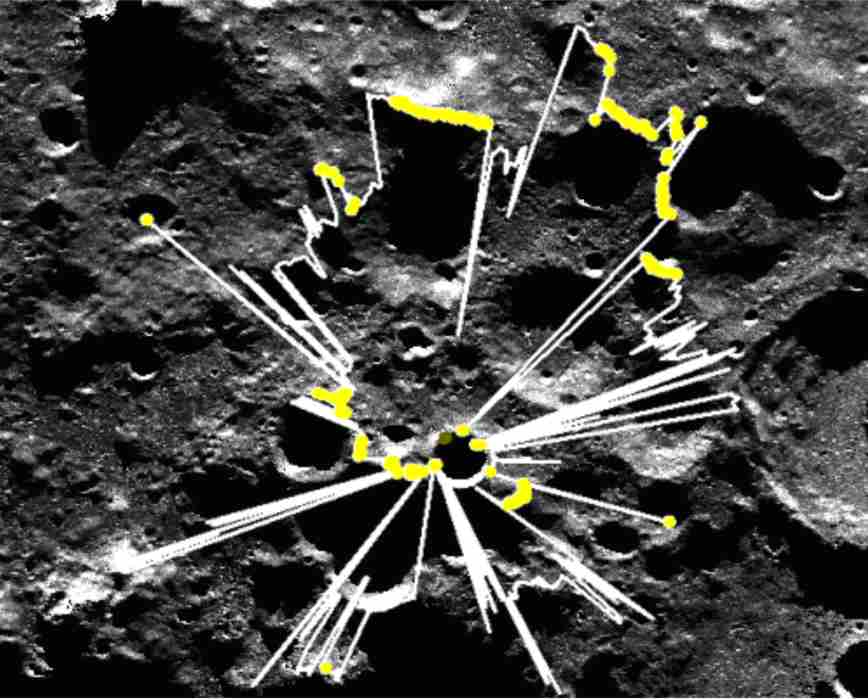
The white lines here show the local horizon as seen from this site in the South pole area on the Shackleton rim, and the yellow regions show the parts of the horizon that block the sun (less than 50% illuminated) on the worst day of the year. (Figure 11, page 16, explanation on page 6 of this paper). As you can see, many of the features that block the light are close to the site itself. Based on the analysis in the paper, this site needs a fast recharge power supply for a maximum of 62 hours or about two and a half days. With a coarser plot, the result was 156 hours, which shows how much a difference the local terrain makes. The results need to be validated against more independent images.
This is work in progress, as results are sensitive to details of the local topography, and the field is changing a lot with new high resolution data. We could do with even better elevation mapping of the poles.
So, the actual figures here might change as we learn more, but the basic idea is clear, that solar collectors on quite a short mast of 10 meters can often significantly reduce the length of the longest period of darkness and that it can also be reduced by using several collectors a few kilometers apart and transmitting power from one to the other.
LONG SHADOWS ON THE MOON, ESPECIALLY AT THE POLES
I haven't found any papers about this yet, so will just describe the issues. If you know of good citations do say. So, the thing is that shadows on the Moon are so very dark, that it's hard to see any features in them. Apollo 11 had to land during a narrow time window of sixteen hours every 29.5 days, so that they could see the lunar features during the descent flight path to the Moon. They could only land when the sun was at an elevation of between 5° to 14°. Too high and the sun would be directly behind them so that they couldn't make out any shadows at all, the landscape would be "washed out". Too low and most of the landscape would be shadowed.
The sun angle at the poles would be far lower, from 0° to around 1.5°, which would probably make it hard to impossible to do an Apollo style visual landing. Most of the landscape would be hidden by the long shadows of boulders, at ground level. We don't need to worry so much about the landing with modern technology and detailed 3D maps of the Moon, but the long shadows have other problems.
It will be hard to just walk around outside the base without artificial light. Although you would be walking in full sunlight, most of the ground at your feet would be in pitch darkness. There'd be some scattered light from the brighter pats of the landscape, but the bright landscape will also stop your eyes from dark adapting, so you won't see much in the darkness. So I think you will need bright lights to shine into the shadows to walk anywhere around the base. I don't see this as much of an issue, but it is something to think about.
Another problem is that if you park a rover next to the habitat, then at certain times of the lunar month, the rover will block the sunlight. It's the same for anything else you park or any structure you put up next to the village. The habitats will block each other as well.
So - this is just a suggestion, but I wonder if it would work best to have a multi-level village? Some of the habitats could be raised on legs above the landscape rather like Belgium's first ever "zero emissions" Antarctic base, the Princess Elisabeth Antarctic Station,
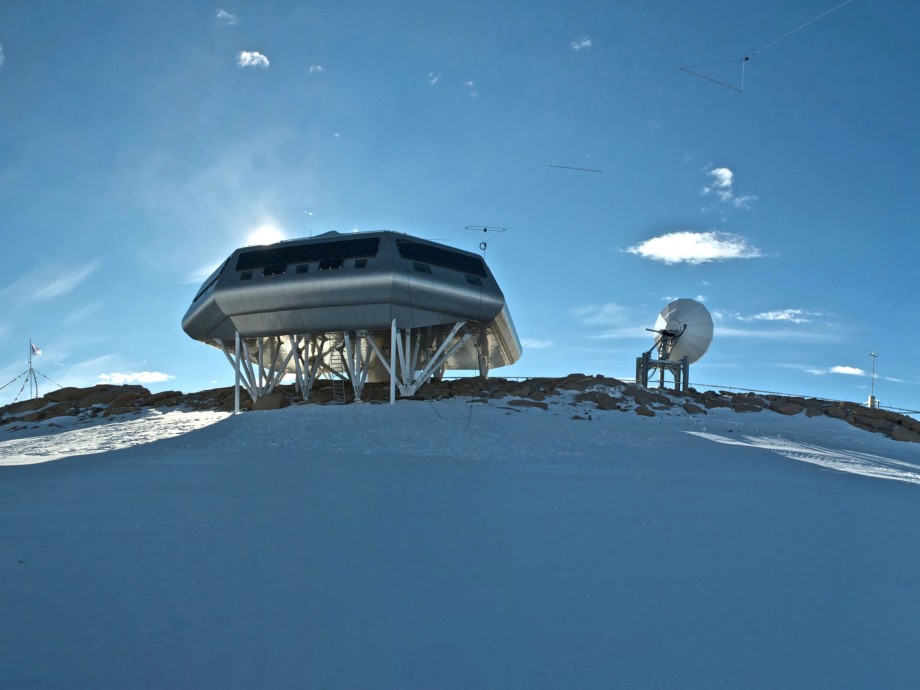
You could park your rovers beneath it. You could also have ramps or lifts to get down to the ground level from above. Of course it would have to be more rounded than this one.
The habitats could also be at slightly different layers and if you had a greenhouse, it could be at the top, center, a few meters above everyone else. The solar panels and solar collectors would be much higher on five or ten meter posts to avoid local relief, so they would not be affected.
HEAT REJECTION
Often it's as much of a problem to keep a space habitat cool as to keep it warm. The ISS has large heat rejecting panels, six of them, each able to reject at least 11.8 kilowatts of excess heat from the ISS. (See also "Explore the Space Station" with the radiators labeled)
This is another advantage of the lunar poles is that it's really easy to design heat radiators. You just need to set the radiators flat on the ground, and then the sun will only ever catch them edge on. They are already in the optimum position for heat rejection, with no need for the radiators to move. (See page 584 of this paper).
It's harder to do this at lower latitudes. One approach is to use heat pumps to increase the temperature to the point where the heat can radiate easily even in the lunar day. Or the heat rejection radiators can be shaded so that they remain cool. Or you can use a combination of both approaches.
FERTILITY OF LUNAR AND MARS SOIL
The easiest way to grow plants for food in space is to use soilless gardening with hydroponic solutions or with aeroponics where plants are grown with roots suspended in a fine mist (uses much less water).
This leads to huge savings in the precious area you need to grow crops. Instead of one acre of farmland needed per person for conventional agriculture (4000 square meters approximately), you can grow 95% of the food, water and oxygen for an astronaut from just 30 square meters, with a conveyor belt system, of rapidly growing crops such as wheat, sedge-nut, beet, carrots, etc. For details see Sending humans to Mars for flyby or orbital missions - comparison of biologically closed systems with ISS type mechanical recycling (also relevant to long duration lunar missions). So early stages of agriculture on the Moon are sure to use more intensive methods such as this.
Soil based gardening can also be used with the methods of biointensive mini gardening. By using good gardening practices and by careful choice of crops you can grow all the food for one person in 4,000 square feet, about 372 square meters, or less than a tenth of an acre. That's intermediate between conventional agriculture and the conveyor belt type system of BIOS-3.
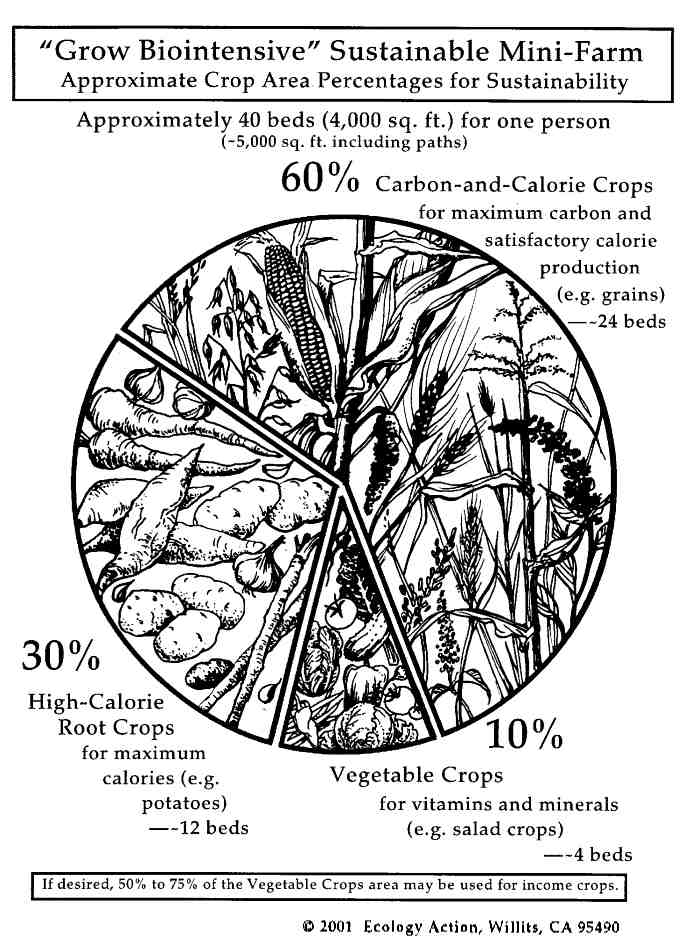
Grow biointensive - sustainable mini farming - this method needs only 372 square meters of growing area per person.
We can get an idea of how efficient these methods are by working out the total land area needed to feed the world on a vegetarian diet by all the methods. With a million square meters to a square kilometer, then we just need to multiply the numbers by 7,500 to get the area in square kilometers needed to feed a population of 7.5 billion. We get
- BIOS-3, 30 m², so 225,000 km²
(smaller than the UK, see list of sovereign states and dependencies by area) - Biointensive mini gardening. 325 m² per person, so 2.44 million km²
(smaller than India at 3.288 million km²) - Conventional agriculture, 4000 m² per person, so 30 million km²
(a little under the area of the US, China and Russia combined)
By comparison, the Sahara desert is 9.2 million km². With the BIOS-3 system, we would need only 2.5% of the Sahara desert to feed the world. The total land area of the Earth is 148 million km². But of course much of that is desert, mountains, ice etc, some is uncultivated and animals require more land area than plants.
The surface area of the Moon is 38 million square kilometers. Indeed, a medium sized lunar crater 535 km across has sufficient land area to feed the whole world using the BIOS-3 system if you had the materials to cover it with greenhouses and enough air and water to produce growing conditions inside all those greenhouses. Mare Imbrium with a diameter of 1146 km has enough surface area to feed the world four times over.
Early experiments involving adding lunar material to hydroponic solutions suggested that the lunar soil was very fertile indeed as the plant growth was enhanced.
However later research suggested that the reason for this was a deficiency of trace elements in the hydroponics solutions used and that the plants were equally stimulated by some terrestrial soils.
A recent experiment using lunar soil simulants instead of the lunar regolith itself, and growing the plants in them directly found that the soil was not particularly good for plants, and that Mars simulants were better. However the Mars simulant contained trace amounts of organics and also held water better than the lunar simulant. Also heavy metals are an issue for Mars soil (they could not eat the results of their experiments because of the possibility of heavy metal concentration) as also is the case for the Moon.
None of this simulates the situation of gardening on the Moon or Mars using the soil itself as that would involve composting the residues of the first generation plants with micro-organisms to make a good top soil. You can't really expect plants to grow well directly in ground up rock without topsoil. Even after a single cycle of composting the residues, the result could be much more fertile.
Experiments with material from Apollo 16 showed that cabbage seedlings accumulated high concentrations of aluminium. Other experiments by Kozyrovska et al show that marigolds grown in terrestrial anorthosite accumulated heavy metals such as zinc, iron, nickel and chromium (lunar anorthosite forms the light areas on the Moon).
However when the marigolds were grown in a community of microorganisms in a model plant microcosm, this protected the marigolds against toxic doses of the heavy metals and also helped deliver essential nutrients to the plants.

Marigold flowers (tagetes patula) photo by Dori - when grown in terrestrial anorthosite (a type of mineral common on the moon) they accumulated heavy metals. However when grown with a community of microorganisms, this protected them against the heavy metals and helped to deliver essential nutrients to the plants.
Kozyrovska et al write:
"Our idea was to use the lunar soil for the pioneer plant growth and to convert the resulting plant biomass into so called protosoil, utilizing an optimized consortium of microorganisms."
Their experiments were promising. See Bioaugmentation in growing plants for lunar bases. The toxic heavy metals seem to be a surmountable issue. Another approach suggested by Haisong Liu et al. is to supply soil, and even seedlings, from Earth to get the process off to a quick start.
I'd like to suggest another idea here. Since hydroponics work well in the BIOS-3 experiments, one could also start by growing the first generation of plants hydroponically. Then you could use the plant residues to inoculate the lunar soil with organic material along with beneficial bacteria.
Also after whatever method is used for the first areas of good top soil on the Moon, the soil itself can then be used to inoculate larger areas of lunar soil with some of the top soil created earlier. The same methods could of course also be used on Mars, and Mars also has heavy metals in its soil. So in this comparison the two come out roughly equal.
Wherever we grow our plants, we just possibly might grow the tastiest chocolate in the universe.
LUNAR CAVES
We can only see a few meters into the lunar caves from the surface, so we don’t know how far they extend, especially since the regions near the pits are probably partly filled in with debris as well. But they could be huge; potentially they can be large enough to fit in a large city, the size of Philadelphia, with space to spare
Lava tube caves on the Moon could be stable up to five kilometers wide in the lower gravity. The black silhouette here shows the city of Philadelphia superimposed in one of these suggested tubes. We know there are rills on Mars this wide and can see cave entrances into them on the surface, in photographs taken from orbit, but we can't see far into them so don't know how large the caves are yet. These huge lava tube caves may have been detected indirectly though, through gravitational anomalies in the Grail spacecraft measurements: Scientists May Have Spotted Buried Lava Tubes on the Moon - see also Grail data points to possible lava tubes on the moon.
Such huge caves are only possible because of the low lunar gravity, as they would collapse on Earth. Similar caves on Earth are far smaller as would be any similar caves on Mars. We don't know for sure if such large caves do exist, but it does have many cave entrances photographed from orbit, which proves that at the least, it has caves with entrances similar in size to Earth cave entrances. Then the extensive systems of rills and the Grail data are suggestive of larger caves to be discovered.
Some of the possible lava tube gravitational signatures are over 100 kilometers long and several kilometers wide. If the Moon does indeed have caves 100 km long and kilometers wide, that's similar in size to the O'Neil cylinder space habitat with a land area of several hundred square miles (the O'Neil cylinder consists of a pair of cylinders, each 20 miles long and 4 miles in diameter, with total land area 500 square miles).
Each such cave could house several million people. This may be a long shot, but isn't it amazing, to think that the Moon could have caves as vast as this, similar in size to an O'Neil cylinder, and we simply wouldn't know yet?
EXAMPLE LUNAR CAVE SKYLIGHTS - LACUS MORTIS, MARIUS PIT AND THE KING-Y NATURAL BRIDGE
The Lacus Mortis area has possible volcanic cinder cones, as well as the more common shield volcano features, rilles, and a partially collapsed cave entrance with a gentle slope leading into it. This is the destination for the Astrobiotics mission in 2014.
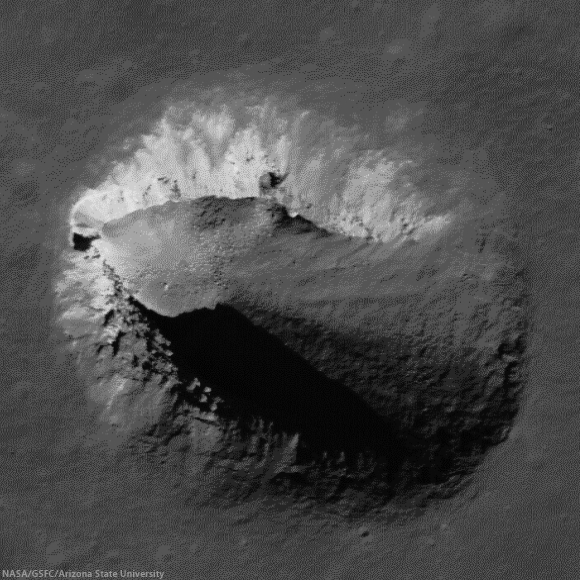
Partially collapsed "skylight" in the Lacus Mortis region of the Moon. Photos of the Lacus Mortis pit from various angles were used to build a 3D model of the pit, assuming that it is a cave entrance.

3D model shown from various angles. The cave was assumed to be oval shaped as a result of fill by debris form the collapse. It may be a shallow slope down into a lava tube type cave shown at bottom right. If it's a lava tube cave, it should widen out to a circular cross section further from the entrance.
Another interesting pit is the Marius Hills pit entrance, original destination for the astrobiotics lander now due to land on the Moon some time in 2017:

The "skylight" on Marius hills (see page 7) was the original objective for the astrobiotics Skylight mission as envisioned in 2013 - it may be an entrance to a much larger lunar cave as it is located on a lunar rille. It's about 40 meters deep The crispness of the landform suggests the collapse happened less than a billion years ago, and the lack of any raised rim or eject suggests it formed through collapse, not through a meteorite impact.
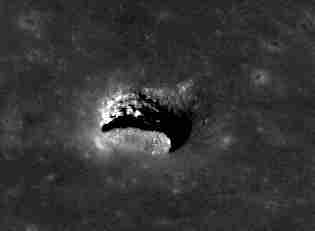
This image shows an oblique view. It's viewed from an angle of 45 degrees, and the light from the sun is at an angle of 34 degrees from the vertical. As a result they were able to confirm that the area of the floor illuminated in this image continues at least twelve meters under the overhang. Papers here, and here .
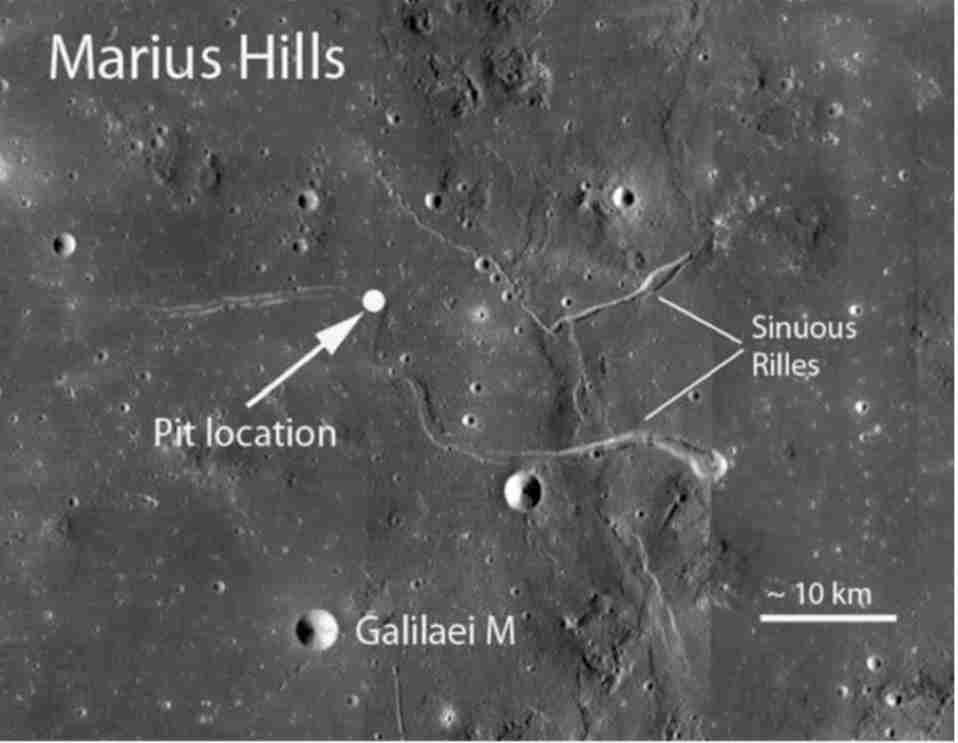
This shows the location of the Marius pit along a lunar rille. Image from page 5 of Exploration of Planetary Skylights and Tunnels
Another "honorable mention" goes to the region of King crater, which is of special interest for its remarkable natural bridge.
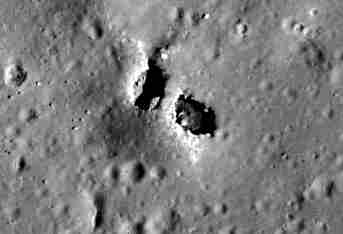
Lunar natural bridge feature King Y, probably caused by a double collapse. It's about 7 meters in width and a 20 meters walk to cross it.
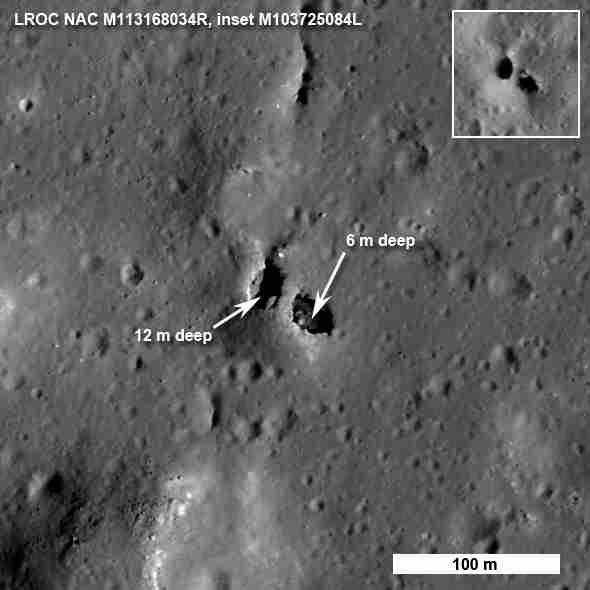
The lunar caves may also have unusual minerals that formed as the lava that created the cave slowly cooled and differentiated.
The NASA PERISCOPE project, currently a phase II concept study, could potentially give us a way to see into lunar caves from orbit using femtosecond laser photography which lets you "see around corners" to parts of the cave that were never within the line of sight of the orbiter.
We may may get our first views into the interior of a lunar cave from ground level some time in 2017, with the Japanese Hayuto Lunar X prize contender Moonraker, which will explore the Lacus Mortis pit "skylight" and then lower its two wheeled rover Tetris into the pit . For details of this mission, see Robotic missions to the Moon, already planned, or near future, from 2017 onwards.
LUNAR CAVES AS A SITE FOR A HUMAN BASE
So, another place we can set up a base is in a lunar cave. See for instance, Technologies Enabling Exploration of Skylights, Lava Tubes and Caves (from 2011). Advantages of the caves include:
- Natural protection from cosmic radiation and solar storms.
- Temperature is lower, but constant and the base would be easy to insulate and keep warm.
- Easy to make a low maintenance airtight enclosure, for instance, by covering the interior of the caves with a layer of glass formed from the regolith dust
- Sunlight can be brought in from the surface through the roof using light pipes / collectors
- However, a base in a cave only has access to nearby sunlight and solar power for 14 days of a lunar month. Some power storage would also be needed for the lunar poles, to deal with the short periods of night they get, including lunar eclipses.
Everything else is great, but the long 14 day lunar night is an issue, unless the cave happens to be right at the poles of the Moon close to the peaks of eternal light - or we dig a huge artificial cave there. However it is easier to cope with a 14 day lunar night than you might think.
PLANTS CAPABLE OF GOOD YIELDS WHEN KEPT IN DARKNESS FOR THE LUNAR NIGHT
It's also possible to deal with the lunar night by reducing the temperature of the plants from 24 °C in the lunar day to 2.5-3 °C in the lunar night (which helps maintain plant vitality during darkness). This was tested in an experiment by the Russians for BIOS-3. Of the ten crops tested, most were able to cope with this regime. The ones that couldn't cope were tomatoes, sedge nuts, and cucumbers. Wheat, barley, peas, turnips, dill, carrots, beet and radish were all able to survive a simulated repeated 14 day lunar night. The edible crops were reduced 30-50%. The most promising ones were carrots (73.5% yield), Beet (yield actually increased to 122%), turnip (57%), dill (72%), and radish (61.5% yield). See table 3 here (I've converted the figures to percentages).
So if you use that approach you'd need up to double the growing area, or around 60 square meters (probably a fair bit less depending on the mix of crops), but would be able to use natural sunlight during the lunar day, so would not need to supply light to the crops during the lunar night at all.

"Wheat plants of various ages showing the "conveyor" approach that was used in the Bios experiments, Young wheat plants are in the foreground, with more mature plants toward the back." Photo from here
In the BIOS-3 experiments they found that Wheat, barley, peas, turnips, dill, carrots, beet and radish were all able to survive a simulated repeated 14 day lunar night and produce reasonable crops of 50 - 70% of the crops achieved with full sunlight. The trick was to reduce the temperature from 24 °C in the lunar day to 2.5-3 °C in the lunar night (which helps maintain plant vitality during darkness)
You could also have a mixed regime, supplying light during the lunar night only to the plants that require it, such as tomatoes, cucumbers, etc, perhaps also extending it to the plants that most benefit from light during the lunar night (for instance, on those figures, the radishes and turnips would benefit most).
CAN WE FILL LUNAR CAVES WITH AIR?
We will surely just bring air from Earth to start with, since it's only a small amount of the launch mass, only 0.26% in the case of the atmosphere in the ISS (not including stored nitrogen). For details, see the Nitrogen section of Case for Moon First. But later on, if we have thousands or even millions living on the Moon, perhaps we might want to fill the entirety of a large cave with air. A cubic kilometer of air weighs 1.225 million tons, which is a lot of nitrogen to find somehow. Could we source it on the Moon? This is for a fair way into the future of course, but let's try to get a rough estimate of whether it is possible.
Let's try a cave 250 meters in diameter, and 100 km long, a medium sized lunar cave (if the Moon does have caves as large as the Grail data and modeling suggests), but huge for Earth. That's 4.9 cubic kilometers of air, so 6 million tons of atmosphere using our 1.225 million tons per cubic kilometer figure (1.225*PI*(0.25/2)^2*100).
That much nitrogen could be sourced on the Moon, using lunar railways to truck it from the poles, if they do have and 600 million tons of volatiles, and 6% nitrogen for a total of 25 million tons of nitrogen. Typical heavy trains on Earth can carry 20,000 tons upwards. So if we had their like on the Moon that would be 300 train trips to fill the cave using volatiles from the poles.
You could also fill the cave pressurized to a tenth of Earth normal, which is enough to grow crops and for humans to walk around using only an oxygen mask, and then have pressurized habitats and greenhouses and parks within it at Earth normal pressure. If you do it that way, you need 600,000 tons of atmosphere for our cave 250 meters in diameter and 100 kilometers long, requiring about 30 trips of a heavy goods vehicle to truck the volatiles from the lunar poles to the cave.
Also, we can do another calculation based on the 225,000 km² needed to feed the population of the Earth on a basically vegetarian diet with the BIOS-3 system. If that area was covered with greenhouses, typical height say 2 meters, that's 550 cubic kilometers which at a mass of 1.225 million tons per cubic kilometer is around 674 million tons. If we pressurized the greenhouses at a tenth of Earth normal, that would be 67.4 million tons. There'd be enough water too, if we use aeroponics.. So, if there are 25 million tons of nitrogen at the poles, the Moon may have enough by way of volatiles to fill greenhouses sufficient to feed 2.78 billion people or 37% of the Earth's population using the BIOS-3 system.
Of course I'm not suggesting we colonize the Moon with nearly three billion people, but it does show that the Moon has a fair bit of potential for gardening just using indigenous resources.
So, yes, we could fill some of the medium sized caves in their entirety in this way (depending on what we find by way of volatiles there).
However, eventually if we had millions living on the Moon and wished to fill all the lunar caves with nitrogen and oxygen, and if some are as large as 5 km diameter and 100 km long, then you have the same problem as you have with an O'Neil cylinder, that in such a large space, the mass of the atmosphere dominates, and nitrogen is in short supply in the inner solar system, apart from on Earth and Venus.
For a cave as large as that, 5 km across and 100 km long, you would need 1.225*PI*2^2*100 million tons = 1.54 billion tons of volatiles, most of that nitrogen. Perhaps you could get it from comets, but they have only around 0.5% NH3 or so (hard to estimate). Perhaps it can be exported from Earth if transport costs go down hugely? Or perhaps you would build domed cities and air filled tunnels on the floors of the caves much as you would do it on the surface, and keep them in vacuum conditions. The reason for building in caves then would be for the protection from cosmic radiation, and micrometeorites and more stable thermal environment.
Anyway - that's for the distant future. It's clear we are not going to run out of volatiles on the Moon any time soon, so long as the volatiles are indeed abundant and easy to mine and transport.
LOW POWER LEDS FOR PLANT GROWTH THROUGH THE LUNAR NIGHT
Lights would be needed in the caves or anywhere on the Moon except the poles, during the long 14 day lunar nights. They would be needed on the poles too, for a few days of the year. But they would also be needed for plants on Mars, during the dust storms, which block out 99% of the sunlight, often for weeks on end.
This used to be a major issue, because the lights for growing plants would consume a lot of the power of a space habitat with a greenhouse. But it's not a big issue any more. This is something that has changed a lot recently with the invention of LED lights optimized to produce only the wavelengths of light needed for crops. You need about 100 watts of supplied power for lighting for one square meter. That's 3 kW per person for 30 square meters. However you only need it for 12 hours a day for 14 days. That makes it a total of 504 kWh of storage needed per person to provide lighting for the lunar night.
POWER DURING THE NIGHT
One way or another you need a way to deal with the periods of darkness. For a detailed working out of power available and requirements for early stages of a lunar polar base (with Shackleton crater at the south pole as an example site for the base), including methods of transmission of the power, and storage on the Moon, see Power System Concepts for the Lunar Outpost.
The 500 kWh per colonist for growing plants during the lunar night corresponds to 750 kg of regenerative fuel cells per colonist. If you can use hydrogen electrolyzed from water during the day, it's more like 17 kg of hydrogen storage per colonist to last them through the lunar night, though that doesn't include the mass needed to store the hydrogen, separate it and recombine it. The ISS and Hubble both use nickel hydride batteries. A new type of battery of this type under development stores 140 kWh per kilogram, so if those were available, you would need about 3.5 kg of batteries per colonist.
This level of power is also just within the range you can supply continuously using standard RTGs - the radioisotope thermoelectric generators - as used for Curiosity, New Horizons, Cassini and many other deep space missions, though it does require a fair number of them. The 3 kWh peak power for plants during the day could be be supplied using 100 kg of plutonium 238 (at 3 watts per kg) or about 150 kg of Americium 241 per colonist. Each colonist has lunar night power requirements for growing crops equivalent to five Cassini spacecraft.
If we start with a lunar colony, as for the ESA village, then in the early days, for the first temporary visits to a polar colony on the Moon, astronauts could avoid the local lunar "winter" and could still be there most of an Earth year. Later you could put panels on several of the lunar peaks of almost eternal sunlight. You could use cables to transmit the power over a short range, and then microwaves or lasers for longer distances. Then the only periods without any solar power would be during the rare total lunar eclipses, requiring only hours of storage rather than days. In that way you would sort out the details of long term storage through the lunar night later on after you already have a fair bit of experience of living in the Moon.
For more on all this, see Power during the night in Case for Moon First,
The Moon is an ideal place to make solar panels, with a hard vacuum, abundant silicon, and the surface regolith can be turned to glass using microwaves as easily as you boil a kettle full of water (because of the pure iron imbedded throughout the regolith in the form of nanophase iron). You could have a solar panel paving robots that travel over the surface making solar panels on the surface using little more than the indigenous resources.
As metal refining takes off on the Moon, you could use HVDC for long distance transmission as is often done on Earth, and eventually have strips of solar panels all the way around the Moon - first at high latitudes and then at the equator too. Since solar panels can be made with indigenous resources and don't have to be shipped from Earth, and the solar panel construction can be automated, with plenty of real estate to cover with the panels, that leaves open the possibility that the Moon could export solar power to Earth in the future.
For more on this, see:
- Powering the whole Moon in the far future
- Possibility of using lunar solar power for Earth
- Lunar railways
WHAT ABOUT EARTH DESERTS?
I'm not urging that we colonize either Mars or the Moon, especially not right away. Rather I would say that we are still at an early exploration stage like the first Antarctic explorers. The explorers need crops and gardens too, especially if they need to stay there for any length of time. But they aren't there to grow crops, and set up home, there's a difference.
Going into space is not an optimal way to create large habitable areas for humans in our solar system at present, as much of Earth is uninhabited. Of course some desert areas are of great ecological interest but there are plenty of places where the desert is not of especial interest, and where colonization would be beneficial.
These deserts on Earth are far easier to colonize than anywhere in space. And what's more, we can use similar techniques, set up enclosures in the desert that are far more habitable than the surrounding desert. We are actually doing this already in a small way, with the salt water greenhouses, so I think you can say that not only should we do it, but we already are. This is an Australian desert project. The sea water is used to make water through the sunlight in the desert, and cool down the greenhouses.
These ideas could be used to reverse desertification in the Sahara desert and other deserts. This is how it works:
Diagrams by Raffa be from wikipedia
It not only lets you grow crops in the greenhouses - it can also help make the surrounding areas more habitable, so you’d get trees and crops growing in an area around the greenhouses as well. Doesn’t extract anything from desert aquifers, rather, it adds to them.
Sundrop farms have a large area set out for greenhouses like this now, in the middle of a desert, so this is taking off in a big way in Australia. Early days yet though.
This video just shows the greenhouses, and when they go inside in the video there is nothing growing there yet, not sure why, maybe it is a new installation, but it shows how it’s quite big in Australia.
There are many countries working on reversing desertification Israel does a lot of reversing of desertification.
One of the worst areas of encroaching desertification is the southern edge of the Sahara desert. The first priority there is to stop the spreading desertification - then to reverse it. Many African countries are collaborating in the Great Green Wall project to plant a forest along the southern edge of the desert.
Then, there is a similar project underway there now to the Australian Sundrop farms, using seawater greenhouses.
Technologies - Sahara Forest Project
This gives far more food and living space for the same amount of cost, compared with the billions of dollars to set up a few people in a space habitat. It's also far far easier to build a greenhouse in a desert on a planet with abundant sea water, and breathable air, than to do it on Mars. And as we just saw, with the BIOS-3 system, we would need only 2.5% of the Sahara desert to feed the world. So if we grew plants on Earth in as small an area as we could do for space habitats, we could feed the entire world easily with minimal impact, at least on the mainly vegetarian diet we would need for space colonies.
SEASTEADING
If we fill all the deserts, or you just don't have a handy desert in your country that's suitable for building on, you can build on the sea, This is still far easier than building in space. That's exactly what this couple did in Canada.
Off the Grid on a Homemade Island moored in the sea off the coast of Vancouver island in Canada. They estimate that the floating structure weighs 500 tons and everything was constructed using a handsaw and hammer without use of power tools.
Imagine how hard it would have been for them to do this on the Moon or on Mars, with a vacuum or near vacuum, having to generate oxygen, scrub the air of noxious gases, somehow get hold of $2 million spacesuits, just to get outside of their door, protect themselves from the cosmic radiation and solar storms, and micrometeorites, somehow hold in the pressure of ten tons of atmosphere per square meter, never mind the difficulty of somehow getting everything there. They wouldn't be able to do it with a handsaw and hammer, for sure.
And actually, there is an idea of floating sea cities, a similar idea to the desert projects, but now just floating in the sea. This is at a much earlier stage, more of a paper project at present. Still it is very similar to the Mars or Moon colony ideas, but much easier to do and floating on the sea.
The Seasteading Institute | Opening humanity's next frontier
We could have sea cities covering much of the seas if we really need more space for people to live.
If self sustaining colonies are indeed possible on the Moon and on Mars, as experiments so far seem to suggest, they would certainly be possible and much easier to construct, floating in the sea. If the 3D printing technology works for space habitats, to make them self sustaining with minimal imports, think how much better they will work on Earth!
By a sea colony here, I mean one that only uses the sea water and the air, with a few imports from Earth - as that would be the equivalent of a Mars habitat. There'd be no need for fishing or anything else, just air, and sea water, and the materials to build the original city, and some imports, and if advocates are right about Mars colonies, there would be little by way of those too.
Four fifths of the surface of our planet is ocean, so if we could live on the sea, in more or less self contained habitats, as with the ideas for Mars, that's be like finding four new planets to live on.

The land area of Mars is roughly the same as the land area of Earth. Four fifths of Earth is ocean, so if we colonized the oceans with floating sea cities, that's the equivalent of four new planets, each the size of Mars, and each far easier and far less expensive to colonize than Mars. Image credit JPL.
The surface area of the Pacific is 165.2 million km². Four times the population of Earth would need about 0.5% of the surface area of the Pacific to grow all of its own food using space colony type technology, if available on Earth rather than in space. Here of course, it would be much simpler, lower cost and lower tech and easier to maintain.
That's actually the aim of the seasteading project too. See their section 5. Sustainability and ecology
"After the concept design is finished, the next challenge is to find the appropriate adaptation strategy – a strategy that creates a safe and livable urban environment on the sea, while minimizing impact on the ecosystems and making efficient use of the available resources. In this section, we explain the Blue Revolution concept and apply it to the seasteading concept"
They explain it in detail there, With its use of aquaponics and aeroponics, it resembles ideas for space habitats.
In a floating sea city like that, you would be in a far better situation than you could ever be on Mars or the Moon. The air is breathable, with no need to generate oxygen or to scrub the air of harmful gases. The Earth as a global system does that for you, just open your windows or make sure you have a bit of ventilation in your homes. There is no need for several meters thickness of cosmic radiation protection. You don’t need to wear spacesuits to go outside to repair the habitat, and there is no need to hold the breathable air in against tons per square meter of outwards pressure. It is hard to beat that.
A sea city would have minimal impact on sea life if done in the same way as for a space colony, growing all their own food inside the habitats. Perhaps this could be one outcome of space settlement, that by learning how to live in space, with such a high priority on efficient recycling, we can also learn to live on Earth as well, with minimal impact. Perhaps both approaches will influence each other.
CASE FOR SENDING HUMANS INTO SPACE
I think there is a case for sending humans into space, I think the Moon is the obvious first destination. Things we can do include
- Detect and deflect asteroids that could impact on Earth
- Supply satellites and other spacecraft with fuel and other components produced on the Moon or from asteroids - for much less cost - possibly - because you eliminate the need to launch the materials to orbit from Earth
- Move some of our heavy industry into space and find metals and other resources.
- Scientific research and astronomical observations ,building Antarctic style bases, and astronomical telescopes and observatories (the Moon has many advantages for some types of telescope, such as infrared telescopes in the passively cooled polar craters, radio telescopes on the far side shielded from radio transmissions from Earth, liquid mirror infrared telescopes in craters, and telescopes networked together using optical interferometry, taking advantage of the stability of the lunar surface)
- Exploration and adventure
- Tourism, could be a major thing for the Moon.
- Manufacturing electronics on the Moon - it’s a high grade vacuum which makes some processes easier to do there than on Earth.
- Manufacture of spacecraft - as industry develops on the Moon, it becomes a natural place to make spacecraft. The only reason that spacecraft have to be made physically small, and unfold, is to fit inside an aeroshell to protect them from the Earth's atmosphere. Spacecraft made on the Moon could be as physically as large as you like, and could be launched into orbit with the solar panels, telescopes etc already in an extended position. The low delta v also makes a huge difference to the amount of mass you can launch through the rocket equation (compare the lunar ascent module used by the astronauts with the Soyuz rocket), so interplanetary spacecraft could be made with cosmic radiation shielding already in place.
- Export of water and other volatiles and rocket fuel from the Moon to LEO. Advocates for this idea predict that the low delta v from the Moon (or almost nothing if you use Hoyt's cislunar tether system) may more than make up for the extra cost of extracting it from the Moon, especially if it is easy to extract water from the lunar poles.
- Solar power. It can actually make sense to do solar power in orbit, because you can use huge thin film mirrors weighing only grams per square meter, to focus the sunlight, onto a central thermal power generator and then safely beam back to Earth using microwaves. Also can be possible to create solar panels on the lunar surface
Note, I don't include Helium 3 in this list. It's a fuel for a technology that doesn't exist yet, some think will never be developed, and most decisive in my view, covering a given area of the Moon with solar panels would generate as much energy in seven years as you'd get from extracting all the Helium 3 from that region to a depth of three meters. So solar power from the Moon seems more viable than Helium 3 extraction as a business case, though Helium 3 would be a useful byproduct of mining operations on the Moon. For more on this see Helium 3 in Case for Moon First.
Many of these ventures would include gardening, growing their own crops, and some would lead to longer term settlement for many years, and possibly eventually colonization. But colonization for its own sake is not currently a good reason in my view, simply because it is so much easier to live on Earth.
Our Earth makes everything so easy for us, compared with space colonies. Perhaps one thing they might do is help us to appreciate quite how valuable and wonderful our Earth is, and how rare, as we look back at the beautiful Earth from the Moon or further afield.

Earth rise over the Moon as photographed from Apollo 8, first mission to orbit the Moon, on Christmas Eve, Dec. 24, 1968
As Carl Sagan in Pale Blue Dot
"The Earth is the only world known, so far, to harbor life. There is nowhere else, at least in the near future, to which our species could migrate. Visit, yes. Settle, not yet. Like it or not, for the moment, the Earth is where we make our stand."
NO RUSH TO SEND HUMANS TO MARS
As for the idea we have to go to Mars to go multiplanetary, no, I don’t think we need to do that at all. I think that a rush to send humans to Mars would
- Spend trillions of dollars, eventually hundreds of trillions if they do it in earnest, on trying to make Mars habitable to humans, that would be much more beneficially used to protect and help Earth. It’s not going to work at all in the near term and probably never - the most optimistic estimates by the Mars society suggest a thousand years involving mega technology such as mining cubic kilometers of fluorite ore on Mars and using 500 half gigawatt nuclear power stations to convert it into greenhouse gases - and even then there is a lot of question about whether that would work.
How likely is it that we would keep up such a project for a thousand years when it is much easier to live on Earth? Then it needs to go on for 100,000 years to get all the carbon sequestered for an oxygen atmosphere, the nitrogen needs to be sourced somehow, many cycles somehow got working on Mars in a different way from Earth, and lots to go wrong and needs mega technology into the indefinite future to keep Mars habitable if it works, always on the edge of reverting to a desert planet again if the greenhouse gas factories fail or the large mirrors in space stop functioning.
If you read Kim Stanley Robinson’s “Mars Trilogy” then that is fantasy / science fiction with a lot of fudging of the numbers for the sake of a good story that plays out in generations instead of millennia. In the Earth’s evolutionary past of course it took many millions of years. For more on this see the section It is not at all clear that we can terraform Mars in Case for Moon First.
- Also, by introducing Earth microbes to the planet, interfere with the process of scientific study of Mars which has potential to lead to the next major discovery in biology as momentous as the discovery of evolution or the helical structure of DNA, through discovery of life. based on different principles form Earth life or better understanding of early stages of how life can evolve from non living chemicals
It's also very unlikely that at this stage we know enough about which microbes to introduce when, never mind introducing a random grab bag of whatever happens to be in human occupied spacecraft, if we do decide to do ecoengineering of Mars. I think it will be a fair while before we are mature enough to understand the consequences and know how to do it, to embark on a career of planetary ecoengineering as a species. We can do it small scale first with Stanford Torus type habitats or lunar caves / city domes, projects that we can complete in a more realistic decade, rather than a hundred thousand years. - Does not help with ensuring the future of our civilization, and indeed by distracting from the problems on Earth, can make things more difficult in the future. There is some merit I think in an offworld backup of knowledge, and seeds. But we don't need to colonize to do that, and can do that on the Moon, the most accessible place to put it outside of Earth, where it will remain unchanged for millions of years into the future. See Backup on the Moon - seed banks, libraries, and a small colony
- No natural cause is going to make humans extinct until half a billion years in the future, such a long timescale that humans could evolve a second time from the smallest multicellular creatures. Our solar system has settled down since the huge craters that hit the Moon during the "late heavy bombardment", with no impactors much larger than around 10 km for the last three billion years on Mars, Mercury, the Moon, Earth and what we have of the history of Venus. Jupiter protects us from large comets and the larger asteroids are all in stable orbits over a millions of years timescale. Jupiter breaks the larger comets up, or diverts them to hit the Sun or ejects them from the solar system or they impact into Jupiter itself. Its defense of Earth is very effective as we can tell by the cratering record the only really big craters are from well over 3 billion years ago the ones for 100 km scale impactors such as Hellas basin on Mars, Aitken crater on the Moon and the Caloris Basin on Mercury all date from well over 3 billion years ago, getting on for 4 billion years ago.
Jupiter is not so effective in preventing smaller impacts, of 10 km or so downwards. But asteroid impacts such as the one that ended the dinosaur era would not make us extinct. 70%, or even 99% of all species extinct equates to zero chance of extinction of such an adaptable creature as us, able to survive on fruit, nuts, seeds, insects, shellfish, animals, birds, and to travel in boats, with minimal technology, and live anywhere from the Arctic to the Kalahari.
As for harm we may do to ourselves, that's as likely to be accelerated as prevented by a rush to send humans into space as quickly as possible. A war or a disease is that it is as likely to engulf colonies or even be started by them as be prevented by them especially as even fatal diseases normally have a latency period before symptoms develop (otherwise they wouldn't be able to spread) and transport to colonies in space would eventually only take weeks or even days. You can do something about it with quarantine, but it's hard to know what time period to set, and there is no need to go into space to set up a habitat with quarantine.
It's possible to make up science fiction scenarios in which space colonies "Save the day", but it's equally possible to make up a scenarios where they cause disaster for Earth. A rush to colonize could lead to either type of outcome.
With a more careful approach we can protect Earth from asteroids, and support it in many ways from space. Then if or when we do have colonies in space, this focus on saving our beautiful Earth as our main priority, I think will lead to a better outcome.
FEEDING THE EARTH
Also there is plenty of space to feed our growing population, if we make more efficient use of the land we have already. There's no need to go into space. Our population growth is leveling off, towards a population of perhaps ten billion by the middle to the end of the century.
We have already reached peak child, and most areas of the world now have fertility levels at or below replacement, and feature a slowly growing, steady or declining population. Our world population continues to grow only because with better health world wide, people on average live longer each year.
The middle of the range projections have the Earth's population trending towards 11 billion by 2100 while lower projections have it level off at ten billion or even start to decline towards the end of the century.

So whatever happens, we aren't headed forMalthusian type exponential growth because we have reached peak child already. In the graph above, the red dotted lines show the upper and lower limits for the 95% prediction interval. The blue lines are for +- 0.5 children per couple average. You can look up the data here, the graphs page for the UN population division.
Though we may not reach peak population this century, most parts of the world have a good chance of stabilizing before then, especially the more developed countries. The least developed countries are the ones that would get most population growth. The most rapid growth is in Africa in the projections. You can see a break down for each region of the world here,

Older figures from 2014. Most of the population growth is in Africa by the end of the century by these figures, with everywhere else leveling off by then, the least developed countries are the ones that grow most rapidly, so that's a reflection of the situation in Africa
So, things are actually looking brighter than one might think. Which isn't to say it will be easy, but there is no reason why we have to ruin ecosystems on Earth.
I think we can benefit Earth by moving some heavy industry into space, but there's no real reason why we can't have a sustainable human population here, and we don't have to export our population into space to keep going. It is just as well, since an exponential growth could never keep going indefinitely.
Within 18,000 years of doubling the population every century, so multiplying the population by a thousand every thousand years, you'd need all the matter in the entire observable universe to make colonists. Taking it to an absurd limit for an upper bound, even if they reduce the mass of each colonist to a single atom, that just extends it to 28,000 years, and if they double every thousand years instead of every century, with single atom colonists, it's 280,000 years. So obviously exponential growth has to stop well before then - even with warp drive if such was possible.
Without warp drive then we run out of mass to make humans much more quickly, well within 11,000 years of doubling every century and within 110,000 years of doubling every thousand years. Calculation indented and coloured purple.
Without a warp drive, then the mass density of space in the vicinity of our solar system is 0.18 to 0.21 solar masses per cubic parsec (calculation by John Bahcall), which works out to roughly one solar mass every 165 cubic light years (a parsec is 34.7 cubic light years). We would need to convert a sun's mass into humans after less than 7,000 years of doubling every century (the mass of the sun is equivalent to around 5*10^19 humans at 5 kg per human).
After 11,000 years of traveling at the speed of light we would have access to = 33.8 billion solar masses, and multiplying the mass of humans by 1000 every 1000 years we would require a trillion solar masses at that point. So without warp drive we run out of matter just to make humans well within 11,000 years. Here I've also ignored the limits on thickness of the galactic disk.
So it is very unlikely that if we meet an extra terrestrial, that they will be in a phase of exponential growth and one way or another we also have to find a way to be able to survive without exponential growth, so we have to find a way to stabilize our population, bring the birth rate to below replacement. Luckily, it seems this happens naturally as countries develop economically and with better health and education.
For more on this: Why ET Populations Can't Continue To Expand For More Than A Few Millennia
FIND OUT MORE
It would take a fair while to explain my reasons why there is no rush to send humans to Mars in detail so to find out more, see:
- Wait, Let's Not Rush To Be Multiplanetary Or Interstellar - A Comment On Elon Musk's Vision,
- Does Elon Musk's Plan Violate The Outer Space Treaty - Planetary Protection For Mars After Human Crashes
You may also be interested in my Could You See Moon City Lights Or A Greenhouse From Earth? Just For Fun and What If The Moon Had Blue Skies? One Small Change To Apollo Photos
This article has material from my Quora answer to Shouldn't we focus on colonizing Antarctica and the Sahara before colonizing Mars? as well as several sections from my Case For Moon First
This article is part of "If You Love Science, Please Don't Rush to Mars", available on kindle, and also to read for free online.
To find out more about the Moon as a destination for humans, see my Case for Moon First.
WHERE TO FIND "CASE FOR MOON FIRST, GATEWAY TO THE SOLAR SYSTEM "
- Buy it from Amazon as a booklet for kindle
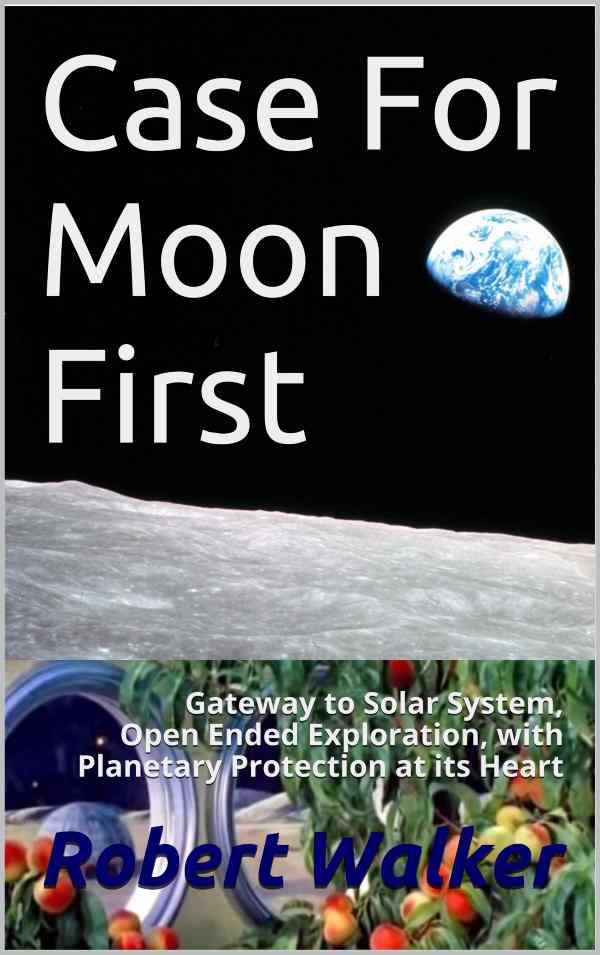
Case For Moon First: Gateway to Solar System - Open Ended Exploration, Planetary Protection at its Heart - kindle edition
- Read it online on my website (free).
- Some of you might also find Pocket useful - I've been suggested this by a keen reader of my posts. It lets you read articles offline without any internet connection. It's free (with a premium version which few people need).
The kindle book may be useful if you want it formatted as a book, which you can read on your kindle, and also on most major smartphones, tablets and computers, using the free kindle reading app.
FACEBOOK GROUP
I've made a new facebook group which you can join to discuss this and other visions for human exploration with planetary protection and biological reversibility as core principles. Case for Moon for Humans - Open Ended with Planetary Protection at its Core
SEE ALSO

Robert Walker's posts - on Quora
And on Science20

Robert Walker's posts on Science20
KINDLE BOOKSHELF ON MY AUTHOR'S PAGE
And I have many other booklets on my kindle bookshelf




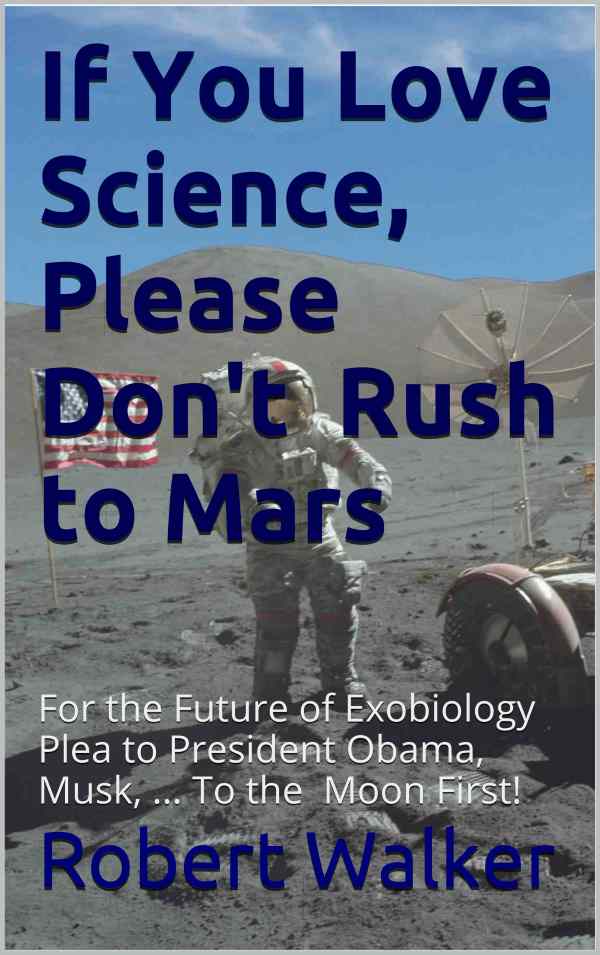


Comments